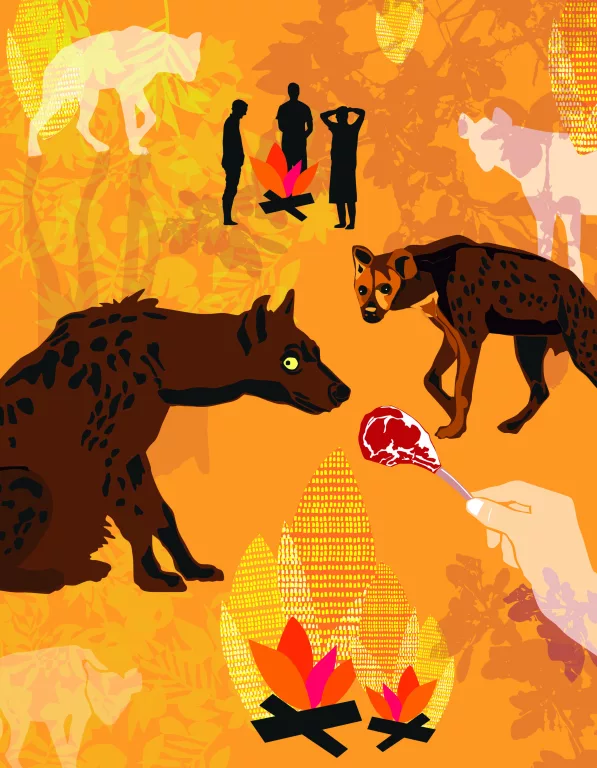[ad_1]
The signs are everywhere: ‘Don’t feed the animals’. After countless visits to Kruger Park, it has become abundantly clear to me that the fences in Kruger are to keep people in, not animals out.
Take, for example, that one July when some friends and I did what we always did when we were home from varsity – we grabbed a braai grid and some tents and gapped it to Kruger.
We booked a campsite at Satara, one of the busier camps, especially in the school holidays, so we knew bagging a spot on the perimeter was out of the question. We’d all grown up in the Lowveld and craved a bush fix whenever we came home, so we took what we could get and set up in the centre of the campsite, surrounded by GP-registered caravans. Long after the evening’s fires had turned to ashy embers, we took a torch and headed for the fence to see what we could see.
Kruger’s nocturnal critters often scurry around the camps in the evening; it’s not uncommon to see a honey badger diving head first into a dustbin, a genet peering down from the trees or a civet padding along in the darkness. Spotted hyenas are a given, so we weren’t surprised to see one skulking along the perimeter, but we were alarmed to find it chomping on a fork full of meat poking through the fence.
Despite their reputation for being lowly scavengers, spotted hyenas are some of Africa’s most powerful predators, capable of hunting in groups or solo with impressive success rates. But there’s no denying they’re opportunists, and will take a free meal wherever they can score one.
Ultimately though, there’s no such thing as a free lunch and down the line that hyena could end up paying a hefty price for that lamb chop. Habituation like this leads to wildlife losing their natural fear of humans, and associating us with food. It’s a dangerous combination and when something tragic inevitably happens, the ‘problem animal’ gets destroyed while the problem humans continue their nonsense behaviour unchecked.
And it’s not just predators. It might seem cute to feed a squirrel or a bird, but the animals don’t care who the food’s intended for, and it becomes less cute when they begin to take what they become accustomed to receiving. I have the stories to prove it: at a picnic site in Kruger, a cheeky yellow-billed hornbill once swooped down and stole a sizzling piece of bacon off of my skottel; another time at a lookout point, a vervet monkey stole the ham right out of my sister’s sandwich before she could take a bite.
Funny in the moment, less funny down the line when that habituated hornbill is the target of a well-aimed cattie, or that monkey targets a child with an ice cream.

Illustration by Jess Nicholson
At Satara, we watched in horror as the campers speared another piece of meat and carefully pushed the fork through the fence, yanking it back as soon as the hyena took grip. Bush kids that we are, we tried to politely intervene for the sake of the hyena. We could not let it slide.
We asked them to stop; they played dumb (or perhaps they weren’t playing at all?) and told us in no uncertain terms to scram. I’m sure if that hyena could talk it would have told us to voetsek too, given its other dinner options involved a lot of running and tearing through flesh, or sniffing out some rotting carrion under a bush somewhere. Understandable.
Not keen on ruining our own evening in our precious park, we left them and the hyena to their questionable buffet.
Early the next morning, I heard a thud. Then another, and another, followed by some Afrikaans expletives. ‘Donderse aape (damn monkeys)!’ Thud, thud.
I unzipped my tent and fumbled for my glasses to make sure my eyes were not deceiving me. One of the fence-side culprits from the night before was throwing naartjies at a small troop of vervet monkeys ransacking her bakkie. Monkeys from elsewhere came bounding in, sights set on this bountiful jackpot. They infiltrated the canopy, throwing things around with abandon and biting everything in sight.
The irony seemed to be lost on this woman. Throwing fruit. At a troop of monkeys. Who were pillaging her car for things like…fruit. Toilet paper, toothpaste and a bottle of Oros came flying out the window, while more monkeys arrived to gather up the citrus flung out the car. She switched to stones when she ran out of naartjies, and we watched her choose a sizeable one, take careful aim and, with some force, send it hurling towards her vehicle. The crack was loud, and gratifying.
Making no attempt to hide our smirks, we packed up our tents while the clever campers tended to their half-shattered windscreen. We headed into the park feeling smug, and satisfied that the karmic wheel in Kruger turns just fine.
Illustration by Jess Nicholson
Follow us on social media for more travel news, inspiration, and guides. You can also tag us to be featured.
TikTok | Instagram | Facebook | Twitter
ALSO READ: Vine of the times: exploring the KwaZulu-Natal wine route
[ad_2]
Source link
Jarastyle – #Karma #Kruger
Courtesy : https://www.getaway.co.za/travel-news/karma-in-the-kruger/

